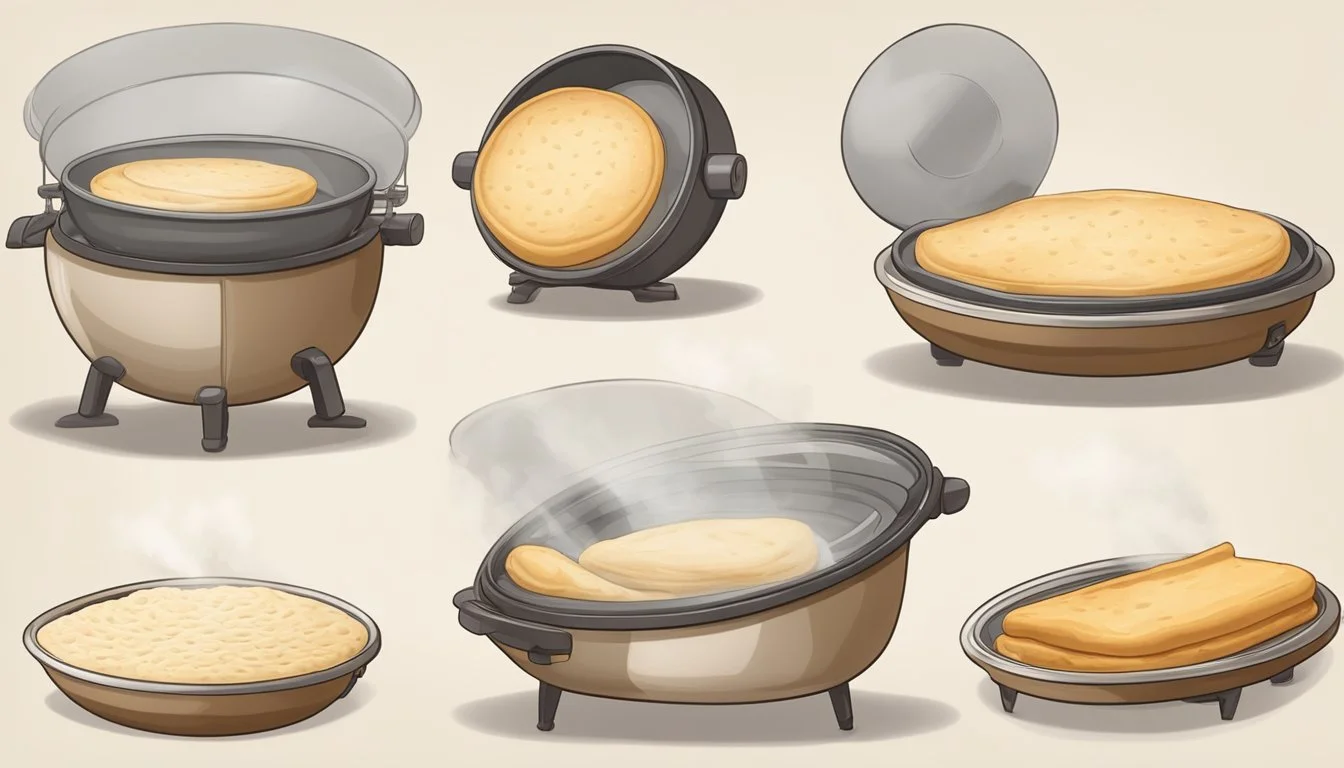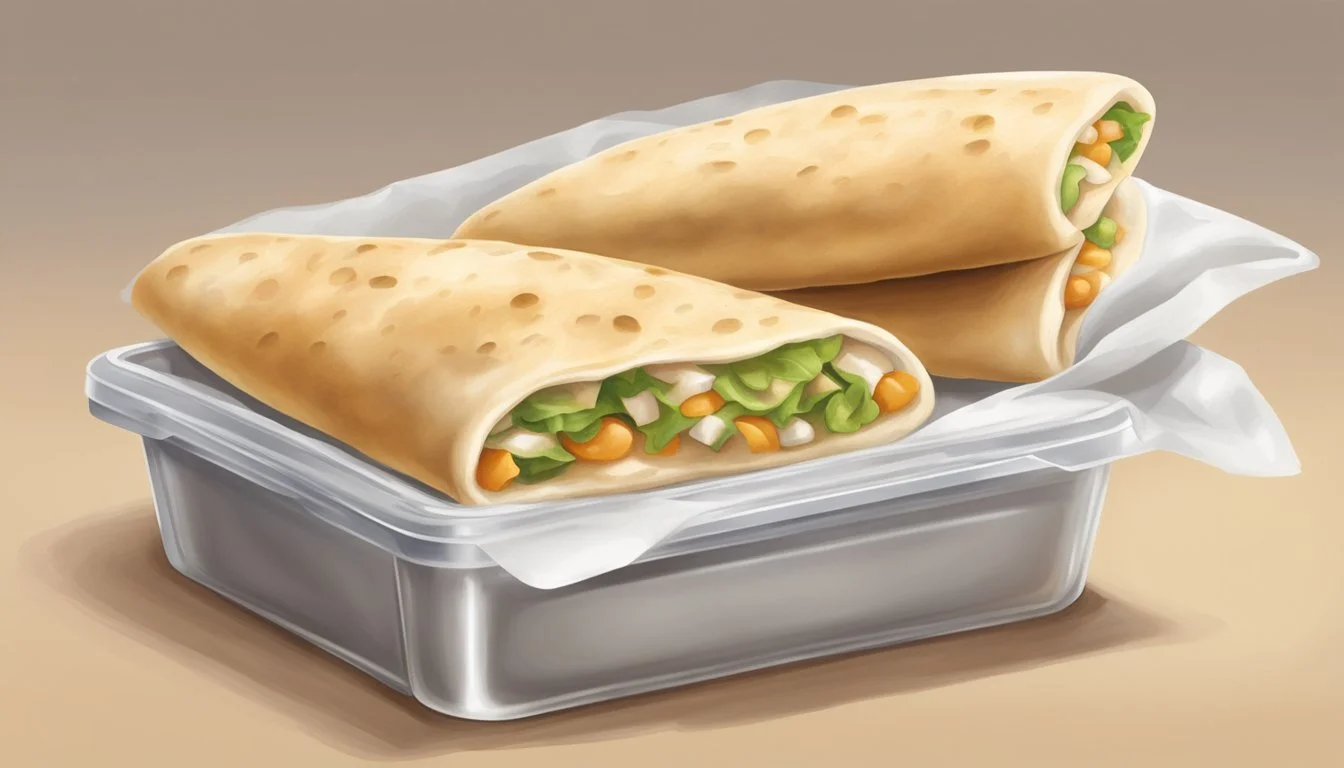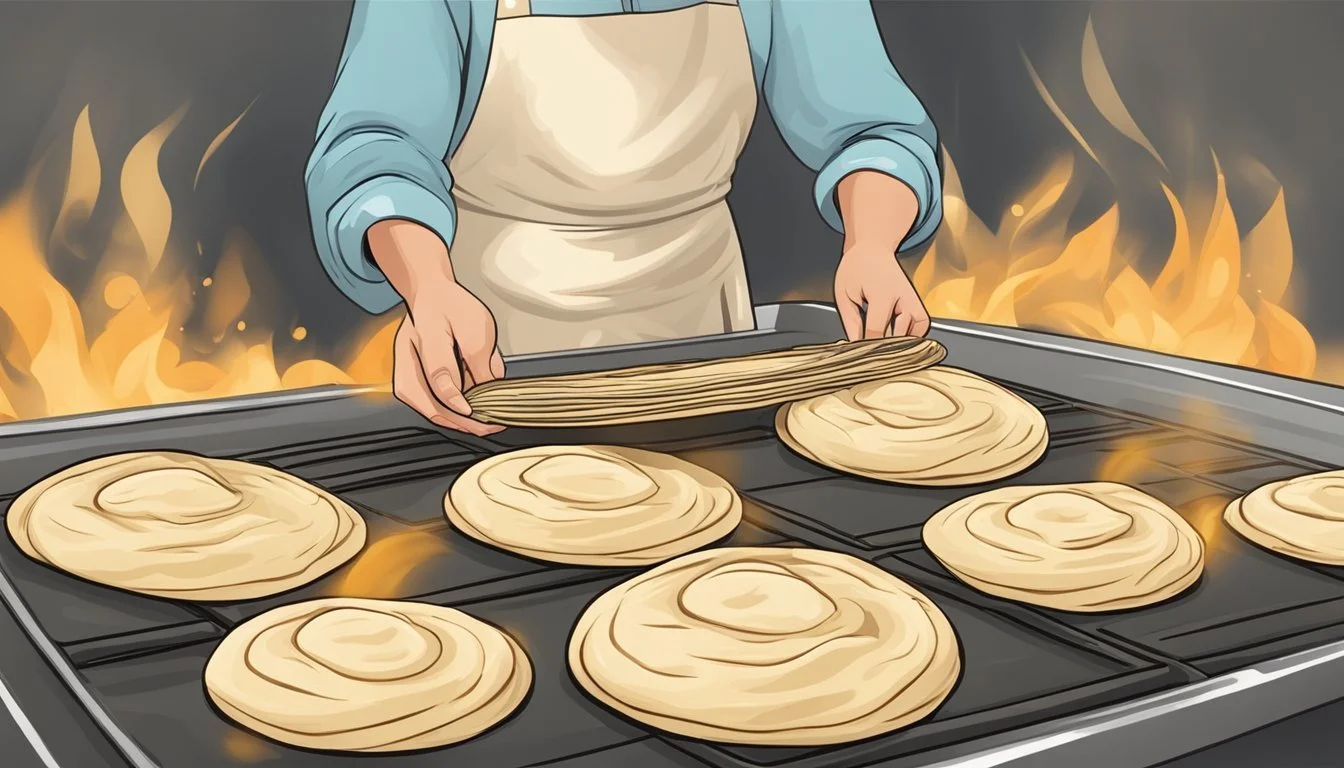Reviving Stale Pita Bread
Simple Techniques for Fresh-Tasting Wraps and Dippers
Pita bread (What wine goes well with bread?) is a staple in many cuisines, renowned for its versatility in dishes ranging from hearty sandwiches (What wine goes well with sandwiches?) to light and satisfying dips. However, the enjoyment of consuming fresh pita can often be hampered by its tendency to become dry and hard when exposed to air. This is largely due to the bread's flat and opened surface, which accelerates the staling process. While fresh pita bread is soft and pliable, making it ideal for various culinary uses, its shelf life is relatively short, and it demands proper storage techniques to maintain its desirable qualities.
The challenge of reviving stale pita bread, though, is not insurmountable. There are proven methods that can restore moisture and flexibility to the bread, turning a potentially wasted product back into an appetizing ingredient. These techniques involve reintroducing moisture in a controlled manner, mimicking the conditions of freshly baked pita bread. For example, employing a damp paper towel with gentle heating or utilizing a skillet with a splash of water can adequately re-soften pita bread, making it once again suitable for folding into wraps or dipping into sauces.
By understanding the underlying causes of pita bread's loss of freshness and employing the right techniques, it is possible to extend the life of pita bread beyond its typical shelf life. As such, learning how to properly revive stale pita ensures that this ancient bread can continue to be a delightful and integral part of meals, with minimal waste and maximum flavour and texture retained.
Understanding Pita Bread
Pita bread is a staple in many cultures, known for its versatility and the pocket it forms when baked properly. This section will explore its composition and the factors that play a role in maintaining its freshness.
Composition and Types
Pita bread, a round flatbread with a pocket, owes its unique characteristics to its simple composition. It is traditionally made from yeast, flour, water, and salt. The yeast acts as a leavening agent, helping the dough rise and creating the trademark pocket when the steam puffs up the bread in the oven. Pita flour is typically high in protein, which contributes to the bread's structure and chewiness. There are different types of pita including:
White Pita: Made with white flour, it has a soft texture and a mild flavor.
Whole Wheat Pita: Includes whole wheat flour for a denser texture and richer flavor.
Gluten-Free Pita: Utilizes gluten-free flour blends for those with gluten intolerance or celiac disease.
Factors Influencing Freshness
The freshness of pita bread is influenced by several factors, with humidity and storage temperature being among the most significant. Ideal storage conditions include:
Temperature: Pita bread should be stored at about 68°F (20°C) to delay the staling process.
Humidity: The bread should be kept in a place with moderate humidity to prevent it from drying out or getting soggy.
The shelf life of pita bread can be shortened by high temperatures and excess humidity, as they can accelerate staling and promote bacterial growth. To maximize freshness, pita bread should be consumed within a few days of purchase or properly stored according to recommended guidelines.
Storing Pita Bread
Properly storing pita bread is essential to maintain its freshness and to extend its shelf life. Pita bread can be stored through short-term methods for immediate consumption, or via long-term solutions to preserve it for future use.
Short-Term Storage
For short-term storage, pita bread should be kept in a cool, dry place away from direct sunlight and heat sources, which can hasten staling. Ideally, maintaining a room temperature around 68°F (20°C) is advisable. To prevent it from drying out:
At Room Temperature: Pita bread can be wrapped in plastic wrap or aluminum foil and placed in a bread box or on a countertop for about 5 to 7 days.
In the Refrigerator: If longer storage is needed, one can wrap the bread in parchment paper and then place it inside an airtight container or ziploc bag to limit exposure to humidity and prevent staleness.
Long-Term Solutions
For keeping pita bread beyond a week, freezing is the most effective method:
Freezing: One should tightly wrap each pita in plastic wrap and then with aluminum foil or place them in ziploc bags. It's crucial to remove as much air as possible to prevent freezer burn.
Thawing: To use frozen pita bread, thaw at room temperature. If planning to consume the bread immediately, it can also be warmed in the oven or toaster for a fresh-baked texture.
Revival Techniques
Reviving stale pita bread can be accomplished through a variety of heat-based methods that restore its softness and flexibility. Each technique caters to different equipment availability and desired bread texture, from crisping up to achieving a pliable wrap perfect for dipping.
Microwave Method
One can soften pita bread in the microwave. The process involves laying the pita on a damp paper towel, sprinkling the pita with a few drops of water, and placing another damp paper towel on top. This trapped steam, when microwaved for 10-30 seconds, helps to soften the bread. Timing may vary with microwave wattage and bread thickness.
Oven Method
For a more uniform and crispy texture, an oven can be used. Preheat the oven to 300-325°F (149-163°C) and place the pita directly on the rack or on a baking sheet. Heat it for 6-7 minutes; this method can slightly crispen the bread while warming it throughout.
Stovetop Method
Using a stovetop, one can swiftly revive pita bread, especially on a gas stove. Lay the pita directly over an open flame for a few seconds on each side until it puffs slightly. On an electric stove, a dry skillet over medium heat works similarly, warming the bread for about 30 seconds per side.
Alternative Methods
Other kitchen appliances like toaster ovens or air fryers are also viable options. With a toaster oven, simply place the pita inside and heat at a medium setting for a minute or two. For an air fryer, heat at 350°F (177°C) for a couple of minutes. These methods may not create an evenly soft texture but will certainly invigorate stale pita bread.
Preventing Staleness
To maintain the freshness of pita bread and avoid staleness, one must focus on proper storage techniques and understand the impact of humidity.
Proper Preservation
Storing pita bread in airtight containers is crucial for keeping it fresh. Exposure to air can quicken the staling process due to oxidation. It's recommended to keep pita bread at room temperature for 5 to 7 days in an environment that is not too warm to prevent it from becoming stale. For longer storage, freezing is an effective method. To freeze pita bread:
Keep it in its original packaging if possible.
Wrap the bread tightly in aluminum foil or plastic freezer wrap.
Place it in the freezer to extend its shelf life while maintaining quality.
When it comes time to thaw, one should remove the bread from the freezer and let it sit at room temperature. This ensures that the bread does not become too moist, which can happen when thawing in a microwave or oven.
Understanding Humidity's Role
Humidity plays a pivotal role in preserving the softness and pliability of pita bread. The ideal storage temperature is around 68°F (20°C) with controlled humidity. Here's how one can manage humidity for pita bread storage:
Airtight containers: These are effective at keeping out excess moisture that can make the bread soggy, as well as preventing the bread from drying out.
Location: Store bread away from moisture-prone areas to avoid dampness that could lead to mold growth.
Taking these steps helps prevent freezer burn for bread stored in the freezer and maintains the desirable qualities of fresh bread when stored at room temperature.
Creative Uses for Stale Pita Bread
When pita bread loses its initial softness, it's not the end of its usefulness in your kitchen. There are numerous recipes and techniques that can transform it, bringing a new crispness and flavor to your meal.
Croutons and Chips
Stale pita bread's inherent texture makes it perfect for creating crispy croutons and chips. These are ideal toppings and sides for various dishes.
Croutons:
Preheat oven to 375°F (190°C).
Cut the stale pita into small cubes.
Toss them with olive oil and seasonings of your choice.
Spread them on a baking sheet.
Bake until golden brown and crispy, approximately 10-15 minutes.
These croutons are excellent as a crunchy addition to soups or salads.
Chips:
Preheat oven to 350°F (175°C).
Slice the pita bread into triangular chip-sized pieces.
Brush each piece with olive oil and a sprinkle of sea salt.
Bake until they reach a crispy consistency, about 10-12 minutes.
Serve them with a dip like hummus or as a standalone snack.
Bread Pudding
Transform stale pita bread into a delightful bread pudding, providing a sweet or savory twist on a classic comfort dish.
Sweet Pudding:
Tear the stale pita into small pieces.
Soak in a mixture of milk, eggs, sugar, vanilla, and cinnamon.
Add raisins or nuts if desired.
Bake in a preheated oven at 350°F (175°C) until set and golden brown.
Savory Pudding:
Cut pita into squares.
Mix with sautéed vegetables, cheese, and herbs.
Pour a blend of eggs and milk over it.
Bake until the top is browned and the center is firm.
Both versions are a resourceful way to use up stale pita and can serve as a hearty breakfast, lunch, or dinner option.
Cooking With Pita
Reviving stale pita bread can transform it into a versatile component for various dishes, from dips to sandwiches to grilled delights. The key to success lies in achieving the right texture—soft and pliable or slightly charred and crispy—depending on the culinary goal.
Pairing with Dips and Spreads
Pita bread pairs exceptionally well with an array of dips and spreads. Traditional Middle Eastern and Mediterranean spreads like hummus and baba ghanoush accentuate the soft, earthy textures of pita. One can also explore combinations with tzatziki or a simple drizzle of olive oil and za'atar. For a more substantial snack, stuffing pita pockets with falafel or gyros meat complemented by fresh vegetables adds a delightful mix of flavors and textures.
Suggested Dip Pairings:
Tzatziki
Olive oil and za'atar
Making the Perfect Sandwich
Pita bread is an excellent choice for sandwiches due to its pocket structure, holding in ingredients neatly. To make the perfect pita sandwich, one should consider the balance of flavors and textures. Start with a base layer of hummus or tahini, followed by a generous serving of protein such as chicken, gyros, or falafel. Adding fresh vegetables like lettuce, tomato, and cucumber ensures a crisp, refreshing bite.
Components for a Pita Sandwich:
Base: Hummus, Tahini
Protein: Chicken, Gyros, Falafel
Vegetables: Lettuce, Tomato, Cucumber
Grilling and Toasting Tips
For a crispier texture, grilling or toasting pita bread enhances its flavor and makes it a perfect side for dipping or a crunchy element in a sandwich. When grilling, lightly brush the pita with olive oil to prevent it from drying out and to achieve a subtle, golden char. A medium-high heat setting on a grill or grill pan is ideal for creating those charred marks without burning the bread. The oven offers a convenient alternative, with a 350°F preheat ensuring an evenly toasted pita.
Tips for Grilling/Toasting Pita:
Brush with olive oil before grilling to avoid drying out.
Grill on medium-high heat for 1-2 minutes each side.
Toast in preheated 350°F oven wrapped in foil for softness.
Conclusion
Properly reviving stale pita bread can transform it from tough and unappetizing to soft, pliable, and ideal for wraps and dippers. The key strategies focus on introducing moisture back into the bread and then applying gentle heat.
Microwave Method: Dampen a paper towel, wrap the pita, and microwave for 30 seconds to one minute.
Skillet Method: Sprinkle water on the bread, and heat it over medium heat until it regains softness.
Oven Method: Brush with olive oil or butter, wrap in foil, and place in a preheated oven for a few minutes.
Storing pita bread effectively helps extend its softness. It should be kept at around 68°F (20°C), away from sunlight and in an airtight container or vacuum-sealed bag. This prolongs its pliability and freshness, reducing the need for revival techniques.
For those passionate about food, understanding how to keep pita bread at its peak is essential. A knowledgeable approach to storing and reviving pita ensures that even leftovers can be a delightful part of meals, whether as a wrap or paired with favorite dips.




